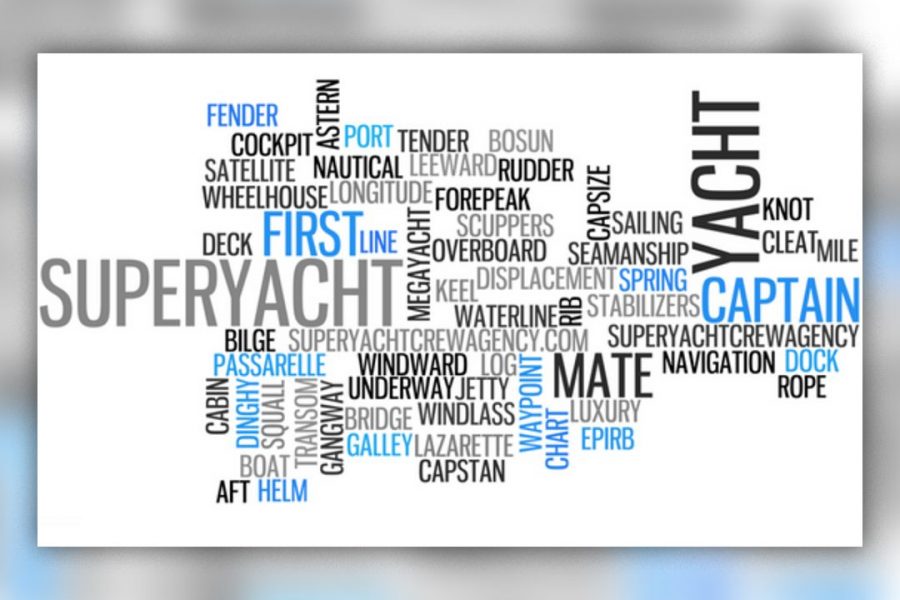MUST KNOW Yachting Lingo for Greenies
Yachting is a unique and exhilarating industry that requires specific knowledge of boat and yachting terminology. If you are new to the yachting world or still consider yourself a greenie, it can be tough to keep up with the lingo. In the yachting industry, communication is key. Knowing the right words is crucial in conveying messages accurately and efficiently. In this blog post, we will explore yachting lingo for greenies and help steer you in the right direction.
If you are reading this, you might also appreciate our previous blog ‘The Key Qualities of an Exceptional Yacht Crew Member’!
Nautical Terminology
The yachting industry has borrowed many words from nautical terminology, words that refer to specific areas of the boat or points of sail. For example, the bow is the front of the boat, while the stern refers to the back. Port and starboard refer to left and right, respectively. Knowing these words is crucial in understanding the language that yacht crew use when communicating.
Deck Terms
The deck of a yacht is where all the action happens. Knowing the terminology for different parts of the deck is important for safety, as well as for communication among crew members. Some common terms to remember include:
– Hatch: an opening in the deck
– Gunwale: the upper edge of the sides of the boat
– Cleat: a metal fitting used for mooring lines
– Windlass: machinery to manipulate an anchor or chain
Boat Parts and Directions
Let’s start with perhaps the most essential vocabulary: boat parts and directions. If you’re not familiar with these terms, you’ll struggle to understand basic instructions on board. Here’s a quick rundown of some of the most important ones:
– Bow: the front of the boat
– Stern: the back of the boat
– Port: the left side of the boat when facing the bow
– Starboard: the right side of the boat when facing the bow
– Aft: toward the stern
– Fore: toward the bow
When communicating directions, it’s crucial to use these terms correctly. For example, if your captain tells you to “head aft,” you need to know which direction that is.
Anchoring
Anchoring is a crucial part of yachting, and it has its own lingo. Here are some terms you should know if you’re involved in anchoring operations:
– Anchor: the device used to secure the boat to the seabed
– Anchor chain: the chain that runs from the boat to the anchor
– Anchor rode: the line that runs from the chain to the anchor
– Scope: the ratio between the length of the anchor rode and the depth of the water. The standard scope is typically 5:1, but it may vary depending on the circumstances.
– Saddle: a term used to describe the shank of the anchor where the chain is connected
If you have made it this far, you’re going to want to read our previous blog The A-Z of yachting jargon!
Boat maneuvers
It’s important to understand the language used to communicate during these operations. Here’s some essential terminology:
– Docking: bringing the boat alongside a dock
– Mooring: securing the boat to a fixed object, such as a buoy or a dock
– Fenders: protective cushions used to protect the boat from damage during docking or mooring
– Lines: ropes used to tie the boat to a dock or buoy
– Spring lines: lines attached to the midpoint of the boat and used to control its lateral movement
Communications
Effective communication is essential in any industry, and yachting is no exception. Marine radio communications have specific procedures and etiquette that are essential to follow. For example, there’s a language for communicating over radio, and you need to know the proper words to use. Mayday is the call of an emergency that requires immediate assistance, while Pan-Pan indicates an urgent situation that needs attention soon.
Safety Terms
Last but not least, safety terms are crucial when working on a yacht, and it is essential to know these terms as early as possible. Here are some safety terms to keep in mind:
– Man overboard: indicates someone has fallen into the water.
– Fire extinguisher: equipment for putting out a fire.
– Lifelines: offering extra protection from going overboard.
Safety Equipment
Yachting is all about safety, and you need to know how to communicate clearly in case of an emergency. Here are some essential safety-related terms:
– Lifeboat: a small boat carried on board to be used in case of emergency
– Flares: signaling devices used to attract attention in an emergency
– Life jackets: personal flotation devices worn to keep someone afloat in the water
– Fire extinguisher: a device used to put out fires
– Mayday: an internationally recognized distress signal used in an emergency situation
If you are a greenie, another previous blog that might interest you is Debunked: The most common yachting questions! Give it a read.
Navigating the language and terminology of yachting can feel overwhelming, but it’s essential knowledge to have for anyone in the industry. Even though it may take a little time to become familiar with every word and phrase, knowing the basics – the nautical terminology, deck terms, communications, knots, and safety terms – will make your life on board and your communication with your crew and guests seamless and effective. The yachting industry is a unique and exciting place to work. Use this post as your guide to mastering the lingo on your next journey on the high seas!
CLICK HERE to see the latest amazing jobs and training opportunities currently listed on yotspot! Good luck with your job search!


